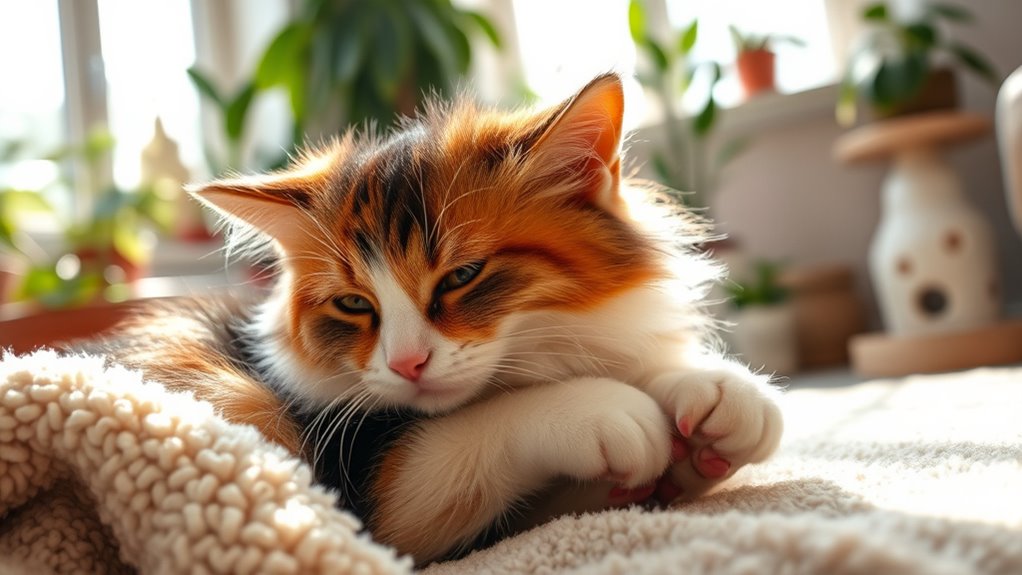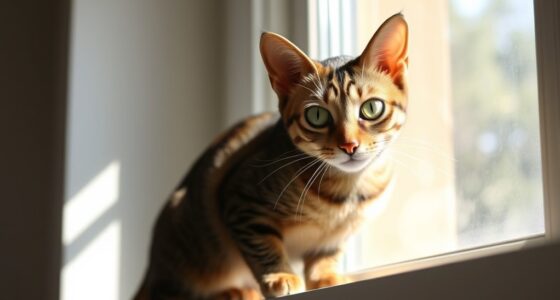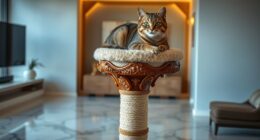Cats knead as an instinctual behavior that goes back to their kittenhood. When they knead, they push their paws in and out against surfaces, showing comfort and affection. This rhythmic action helps them feel secure, as it reminds them of nursing from their mother. Kneading also leaves scent marks, reinforcing their bond with you and their environment. If you’re curious about the different factors influencing this behavior, there’s more to explore on this fascinating feline instinct.
Key Takeaways
- Kneading, or “making biscuits,” originates from kittenhood to stimulate milk flow from the mother’s belly.
- This behavior signifies comfort, happiness, and contentment in adult cats, promoting relaxation through endorphin release.
- Cats possess scent glands in their paws, which they use to mark territory and establish a sense of ownership.
- Kneading frequency varies among cats based on personality, upbringing, and environmental factors, making it a unique behavior for each cat.
- Overall, kneading is a natural behavior reflecting a cat’s bond with its owner and environment, and should not be discouraged.

Have you ever wondered why your cat kneads on your lap or a soft blanket? This adorable cat behavior isn’t just a quirk; it’s deeply rooted in their history and feline anatomy. Kneading, often referred to as “making biscuits,” is a rhythmic action where your cat pushes their paws in and out against a surface. This behavior can be traced back to kittenhood when they kneaded their mother’s belly to stimulate milk flow. Even as adults, many cats continue this comforting action, but the reasons behind it are more complex than you might think.
One reason your cat may knead is to show contentment. When they cuddle up to you and start kneading, they’re expressing happiness and affection. This instinctual behavior is a way for them to create a cozy environment, reminiscent of the security they felt as kittens. The act of kneading can release endorphins, making your cat feel relaxed and satisfied. So, when you see those little paws working away, remember that it’s a sign your feline friend feels safe and loved in your presence.
Kneading also serves a practical purpose, connected to their feline anatomy. Cats have scent glands in their paws, which means kneading can be a way for them to mark their territory. By kneading on your lap or a favorite blanket, they’re leaving their scent behind, fundamentally claiming that spot as their own. This behavior can be particularly common in cats that are more attached to their humans, reflecting their desire to possess a piece of their owner’s space.
Interestingly, not all cats knead, and the frequency can vary among individuals. Factors like personality, upbringing, and environment play a role in whether your cat engages in this behavior. For some, it might be a comforting ritual; for others, it could just be an occasional act. If you notice your cat kneading, don’t discourage it; it’s a natural behavior that brings them comfort.
Frequently Asked Questions
Do All Cats Knead, or Just Some Breeds?
Not all cats knead, but many do, with about 70% of cat owners reporting their pets engaging in this behavior. Kneading frequency can vary based on individual personality and cat breed tendencies. For instance, Ragdolls and Maine Coons are known to knead more often than other breeds. So, while you’ll find some cats kneading more than others, it really depends on the unique traits and habits of each feline friend.
Can Kneading Be a Sign of Stress?
Yes, kneading can be a sign of stress in cats. When you notice your cat kneading, it might be trying to find comfort and relieve anxiety. This behavior can serve as an anxiety indicator, signaling that your furry friend is feeling overwhelmed. By kneading, your cat may be seeking a familiar, soothing action to help calm its nerves. Keep an eye on your cat’s environment to make certain it feels safe and secure.
Is Kneading Common in Older Cats?
Yes, kneading is common in older cats! As your feline friend ages, you might notice this comforting behavior more frequently. It’s a natural part of their cat behavior, rooted in their early feline development. Kneading can provide a sense of security, helping them feel relaxed and content. Ever wonder why your cat seems to find that perfect spot to knead? It’s their way of creating a cozy environment, just like they did as kittens!
How Can I Stop My Cat From Kneading?
To stop your cat from kneading, redirect their behavior. Provide a designated soft blanket or a favorite toy to knead instead. You can also gently discourage the action by using a firm “no” when they start. Make sure your cat’s needs are met, as boredom can lead to excessive kneading. Regular playtime can improve their overall pet health and reduce this cat behavior. Consistency is key, so be patient as they adjust.
Do Cats Knead More When They’re Happy?
Absolutely, cats knead more when they’re happy! You’ll notice their little paws working away, which is a delightful cat behavior and an emotional expression of comfort and contentment. When your feline friend feels safe and loved, that kneading action can become a regular part of their routine. So, if you see your cat kneading, it’s a good sign they’re feeling right as rain in their cozy world with you!
Conclusion
In the end, kneading is your cat’s way of expressing comfort and affection, a cozy reminder of their kittenhood. It’s like a warm hug on a chilly day, connecting you both in a silent language of love. So, the next time you feel those little paws rhythmically pressing against you, cherish that moment. It’s not just a quirky behavior; it’s your feline friend’s way of saying, “I trust you, and I feel at home.”










